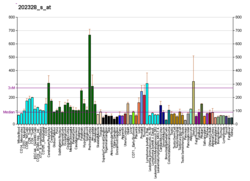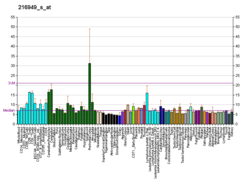(Redirected from Polycystin-1 )
Family of transport proteins
PKD1 Identifiers Aliases PKD1 , PBP, Pc-1, TRPP1, polycystin 1, transient receptor potential channel interacting, PC1External IDs OMIM : 601313 ; MGI : 97603 ; HomoloGene : 250 ; GeneCards : PKD1 ; OMA :PKD1 - orthologs Gene location (Mouse ) Chr. Chromosome 17 (mouse) Band 17 A3.3|17 12.4 cM Start 24,549,834 bp End 24,596,508 bp
RNA expression patternBgee Human Mouse (ortholog)Top expressed in right hemisphere of cerebellum anterior pituitary right frontal lobe gastric mucosa ascending aorta Descending thoracic aorta muscle layer of sigmoid colon body of uterus right coronary artery popliteal artery
Top expressed in cerebellar cortex layer of retina neural layer of retina primary visual cortex Hypothalamus superior frontal gyrus islet of Langerhans uterus olfactory bulb striatum of neuraxis
More reference expression data
BioGPS
Wikidata
Polycystin 1 (PC1 ) is a protein that in humans is encoded by the PKD1 gene . Mutations of PKD1 are associated with most cases of autosomal dominant polycystic kidney disease , a severe hereditary disorder of the kidneys characterised by the development of renal cysts and severe kidney dysfunction.
Protein structure and function
PC1 interacts with polycystin 2 by a cytoplasmic coiled-coil domain. PC1 is a membrane-bound protein 4303 amino acids in length expressed largely upon the primary cilium , as well as apical membranes , adherens junctions , and desmosomes . It has 11 transmembrane domains , a large extracellular N-terminal domain, and a short (about 200 amino acid) cytoplasmic C-terminal domain. This intracellular domain contains a coiled-coil domain through which PC1 interacts with polycystin 2 (PC2), a membrane-bound Ca-permeable ion channel .
PC1 has been proposed to act as a G protein–coupled receptor . The C-terminal domain may be cleaved in a number of different ways. In one instance, a ~35 kDa portion of the tail has been found to accumulate in the cell nucleus in response to decreased fluid flow in the mouse kidney. In another instance, a 15 kDa fragment may be yielded, interacting with transcriptional activator and co-activator STAT6 and p100 , or components of the canonical Wnt signaling pathway in an inhibitory manner.
The structure of the human PKD1-PKD2 complex has been solved by cryo-electron microscopy , which showed a 1:3 ratio of PKD1 and PKD2 in the structure. PKD1 consists of a voltage-gated ion channel fold that interacts with PKD2.
PC1 mediates mechanosensation of fluid flow by the primary cilium in the renal epithelium and of mechanical deformation of articular cartilage .
Gene
Splice variants encoding different isoforms have been noted for PKD1 . The gene is closely linked to six pseudogenes in a known duplicated region on chromosome 16p.
References
^ GRCh38: Ensembl release 89: ENSG00000008710 – Ensembl , May 2017
^ GRCm38: Ensembl release 89: ENSMUSG00000032855 – Ensembl , May 2017
"Human PubMed Reference:" . National Center for Biotechnology Information, U.S. National Library of Medicine ."Mouse PubMed Reference:" . National Center for Biotechnology Information, U.S. National Library of Medicine .Hughes J, Ward CJ, Peral B, Aspinwall R, Clark K, San Millán JL, Gamble V, Harris PC (June 1995). "The polycystic kidney disease 1 (PKD1) gene encodes a novel protein with multiple cell recognition domains". Nature Genetics . 10 (2): 151–60. doi :10.1038/ng0695-151 . PMID 7663510 . S2CID 20636101 .
"Polycystic kidney disease: the complete structure of the PKD1 gene and its protein. The International Polycystic Kidney Disease Consortium" . Cell . 81 (2): 289–98. April 1995. doi :10.1016/0092-8674(95)90339-9 . PMID 7736581 . S2CID 11114706 .Torres VE, Harris PC, Pirson Y (April 2007). "Autosomal dominant polycystic kidney disease". Lancet . 369 (9569): 1287–301. doi :10.1016/S0140-6736(07)60601-1 . PMID 17434405 . S2CID 1700992 .
^ Zhou J (2009). "Polycystins and primary cilia: primers for cell cycle progression". Annual Review of Physiology . 71 : 83–113. doi :10.1146/annurev.physiol.70.113006.100621 . PMID 19572811 .
Dalagiorgou G, Basdra EK, Papavassiliou AG (October 2010). "Polycystin-1: function as a mechanosensor". The International Journal of Biochemistry & Cell Biology . 42 (10): 1610–3. doi :10.1016/j.biocel.2010.06.017 . PMID 20601082 .
Trudel M, Yao Q, Qian F (January 2016). "The Role of G-Protein-Coupled Receptor Proteolysis Site Cleavage of Polycystin-1 in Renal Physiology and Polycystic Kidney Disease" . Cells . 5 (1): 3. doi :10.3390/cells5010003 . PMC 4810088 . PMID 26805887 .
Chauvet V, Tian X, Husson H, Grimm DH, Wang T, Hiesberger T, Hieseberger T, Igarashi P, Bennett AM, Ibraghimov-Beskrovnaya O, Somlo S, Caplan MJ (November 2004). "Mechanical stimuli induce cleavage and nuclear translocation of the polycystin-1 C terminus" . The Journal of Clinical Investigation . 114 (10): 1433–43. doi :10.1172/JCI21753 . PMC 1052027 . PMID 15545994 .
Low SH, Vasanth S, Larson CH, Mukherjee S, Sharma N, Kinter MT, Kane ME, Obara T, Weimbs T (January 2006). "Polycystin-1, STAT6, and P100 function in a pathway that transduces ciliary mechanosensation and is activated in polycystic kidney disease" . Developmental Cell . 10 (1): 57–69. doi :10.1016/j.devcel.2005.12.005 . PMID 16399078 .
Lal M, Song X, Pluznick JL, Di Giovanni V, Merrick DM, Rosenblum ND, Chauvet V, Gottardi CJ, Pei Y, Caplan MJ (October 2008). "Polycystin-1 C-terminal tail associates with beta-catenin and inhibits canonical Wnt signaling" . Human Molecular Genetics . 17 (20): 3105–17. doi :10.1093/hmg/ddn208 . PMC 2722884 . PMID 18632682 .
Shi Y, Mei C, Zhou Q, Wang T, Yu S, Lei J, Ge X, Hu F, Su Q (2018-09-07). "Structure of the human PKD1-PKD2 complex" . Science . 361 (6406): eaat9819. doi :10.1126/science.aat9819 . ISSN 0036-8075 . PMID 30093605 .
Nauli SM, Alenghat FJ, Luo Y, Williams E, Vassilev P, Li X, Elia AE, Lu W, Brown EM, Quinn SJ, Ingber DE, Zhou J (February 2003). "Polycystins 1 and 2 mediate mechanosensation in the primary cilium of kidney cells". Nature Genetics . 33 (2): 129–37. doi :10.1038/ng1076 . PMID 12514735 . S2CID 23149223 .
"Entrez Gene: PKD1 polycystic kidney disease 1 (autosomal dominant)" .
External links
PDB gallery
1b4r : PKD DOMAIN 1 FROM HUMAN POLYCYSTEIN-1
TRP channelmodulators TRPA TRPC TRPM TRPML TRPP TRPV Activators
2-APB 5,6-EET 9-HODE 9-oxoODE 12S-HETE 12S-HpETE 13-HODE 13-oxoODE 20-HETE α-Sanshool (ginger , Sichuan and melegueta peppers )Allicin (garlic )AM404 Anandamide Bisandrographolide (Andrographis paniculata Camphor (camphor laurel , rosemary , camphorweed , African blue basil , camphor basil )Cannabidiol (cannabis )Cannabidivarin (cannabis )Capsaicin (chili pepper )Carvacrol (oregano , thyme , pepperwort , wild bergamot , others)DHEA Diacyl glycerol Dihydrocapsaicin (chili pepper )Estradiol Eugenol (basil , clove )Evodiamine (Euodia ruticarpa Gingerols (ginger )GSK1016790A Heat Hepoxilin A3 Hepoxilin B3 Homocapsaicin (chili pepper )Homodihydrocapsaicin (chili pepper )Incensole (incense )Lysophosphatidic acid Low pH (acidic conditions)
Menthol (mint )N-Arachidonoyl dopamine N-Oleoyldopamine N-Oleoylethanolamide Nonivamide (PAVA) (PAVA spray )Nordihydrocapsaicin (chili pepper )Paclitaxel (Pacific yew )Paracetamol (acetaminophen) Phenylacetylrinvanil Phorbol esters (e.g., 4α-PDD )Piperine (black pepper , long pepper )Polygodial (Dorrigo pepper )Probenecid Protons RhTx Rutamarin (Ruta graveolens Resiniferatoxin (RTX) (Euphorbia resinifera /pooissonii Shogaols (ginger , Sichuan and melegueta peppers )Tetrahydrocannabivarin (cannabis )Thymol (thyme , oregano )Tinyatoxin (Euphorbia resinifera /pooissonii Tramadol Vanillin (vanilla )Zucapsaicin Blockers
See also: Receptor/signaling modulators • Ion channel modulators
Categories :
Text is available under the Creative Commons Attribution-ShareAlike License. Additional terms may apply.
**DISCLAIMER** We are not affiliated with Wikipedia, and Cloudflare.
The information presented on this site is for general informational purposes only and does not constitute medical advice.
You should always have a personal consultation with a healthcare professional before making changes to your diet, medication, or exercise routine.
AI helps with the correspondence in our chat.
We participate in an affiliate program. If you buy something through a link, we may earn a commission 💕
↑









